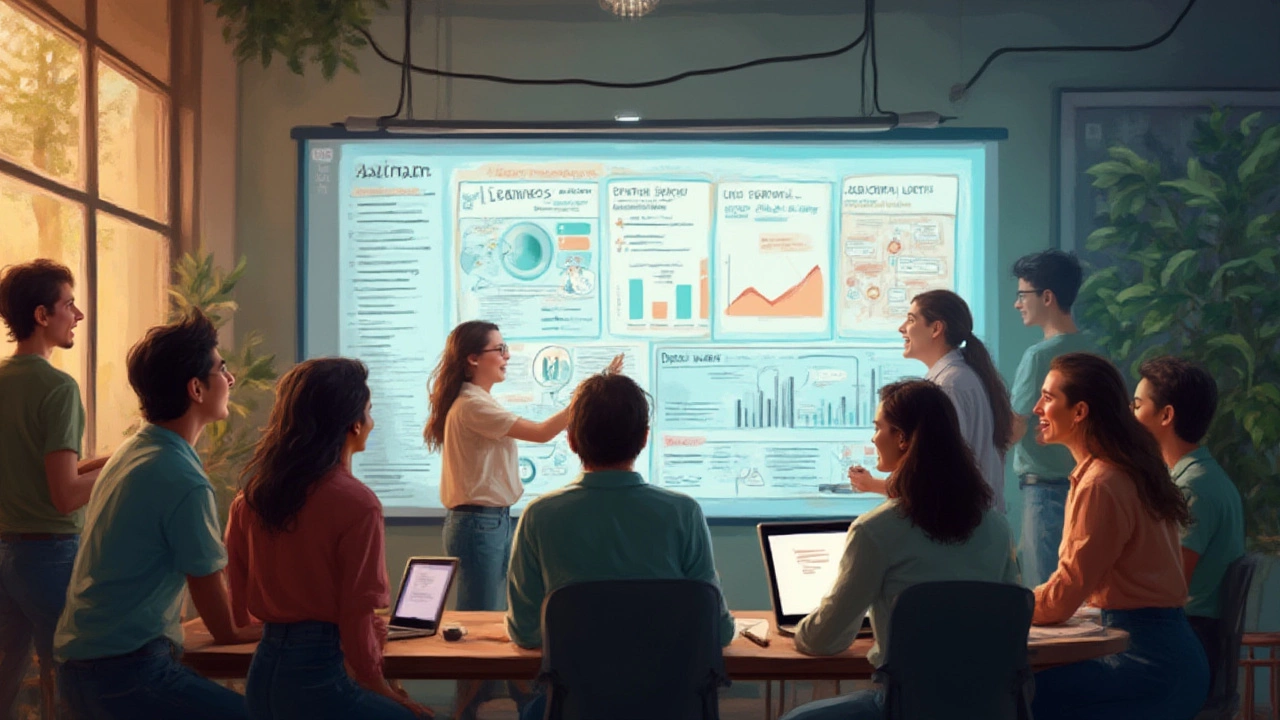Kids in secondary school right now will never know the pain of a clunky, broken lesson halfway through just as you were getting the hang of multiplying decimals. SCORM held things together for a couple of decades, but if you’ve logged into an LMS (Learning Management System) lately, you’ve probably seen that old standard fading into the background. It’s dying for good reason—our lives and the tech we use are moving way too fast for hefty zip files and browser-only playbacks. So, what’s actually taking its place? Here’s what you need to know, whether you're building content, running a school, or you just want digital learning to be a bit less awkward for your kids (like Eliora, who gets cross if a quiz takes more than two seconds to load).
Why SCORM Had to Go: The Problems With the Old Standard
Back in the early 2000s, eLearning was mostly clunky work compliance modules and boring click-next lessons. SCORM replacement wasn’t even part of the conversation—everyone just wanted the stuff to run. SCORM, which stands for Sharable Content Object Reference Model, glued together content and LMSs by letting lessons track if you’d finished them, let you bookmark your spot, and maybe record a quiz score or two. But as years passed, everything else got smart: phones, watches, cars. Yet SCORM didn’t budge. It’s not mobile-friendly, can’t track real-world experiences, and any update is a pain. If you ever had a SCORM package break because Chrome updated, you know the headache. It made eLearning creakier as years went by.
The real nail in the coffin was around data. Modern education is about more than just ticking boxes—schools and businesses want to see how folks are learning in real life, not just whether someone clicked ‘Next.’ SCORM basically shrugs its shoulders if you try to record anything that happens outside the LMS. Some folks even call it “the digital VHS.” Harsh, but not wrong.
And then you’ve got user experience. If you want to launch a survey on your phone or mix real classroom events (like workshops or VR field trips) into your learning system, SCORM just sits there pretending it never saw you. The world’s not just about computers on desks anymore. Between tablets, phones, and even voice assistants, everyone expects modern learning to work everywhere. SCORM didn’t, couldn’t, and honestly never will.
The Main Players Replacing SCORM: xAPI, cmi5, and the Modern Landscape
The biggest challenger is xAPI, also known as Experience API or Tin Can. Picture this: You run a digital safety drill, log off, then go to a hands-on workshop, and a few days later, practice the moves in AR. Instead of these activities being in different silos, xAPI ties them together—wherever and whenever they happen. It captures “learning experiences” everywhere, not just in-browser. You can track if someone watched a video, joined a webinar, used a mobile app, or even visited a physical exhibit. Each event gets logged with a simple structure: actor, verb, and object (like "Eliora completed Chemistry VR Lab").
xAPI replaces the old LMS reporting clunkiness with something called an LRS (Learning Record Store). This isn’t just a tech detail; it lets teachers and managers actually use the data to spot gaps, reward high-performers, or fine-tune lessons. No more “John hasn't finished the quiz” updates—now you get “John practiced CPR for 7 minutes on Tuesday in the hospital simulator.” As a parent, that sounds a whole lot more useful to me than the tick-box reports of old.
Then there’s cmi5, which builds on top of xAPI. It brings in some structure, like packaging content for launching in LMSs, but still keeps the flexibility and tracking of xAPI. It’s like if you took all the good bits of SCORM—the launch-and-track, sequencing, and easy package uploads—and glued them onto xAPI’s modern insights. In 2025, cmi5 is quietly becoming the default bridge between “old school” LMSs and all these new tools.
Here’s how they play together:
- xAPI tracks learning everywhere (phone, VR, real-world events, etc.)
- cmi5 gives structure, so you can launch and track xAPI stuff in an LMS
- LRS acts as the ‘black box’ of learning, storing rich learning data
The standards now being adopted are built for this always-connected, multi-device world. They’re not retrofitted—this is a ground-up rebuild. And vendors are actually on board. In Australia, most uni and TAFE systems are either piloting or fully shifting off SCORM to these standards for new courses. No more patching up broken file packages or hassling IT every time Chrome or Safari gets an update.
| Standard | Launch Year | Device Support | Tracks Real-World Learning | Learning Data Granularity |
|---|---|---|---|---|
| SCORM 1.2 | 2001 | Desktop only | No | Basic (completion, score) |
| xAPI (Tin Can) | 2013 | All (Desktop, Mobile, VR/AR) | Yes | Detailed (actions, locations, times) |
| cmi5 | 2016 | All | Yes | Detailed + Packaging |
Data, Tracking, and Privacy: What’s New with xAPI and cmi5?
If you’re like me, you care about what learning data gets collected and who sees it. While the promise of xAPI is richer tracking (like logging every training session from anywhere), it also means a huge increase in the amount of personal info swirling around. The future’s not just about “Did they finish the quiz?” it’s “How did they practice, where, for how long, and in what order?”
Here’s where modern standards shine if you set things up right. LRS platforms now offer granular privacy controls. Admins can decide what’s logged, who can access learning statements, and how long records are stored. For example, in early rollouts at TAFE SA, learners got dashboards that showed not just their grades, but breakdowns of practice hours, quiz attempts, even skills logged at external partner sites. This lets students spot their own gaps—or swing by for help before it’s too late. As a parent, I love that transparency (it means no more "I did all my work, honest!" followed by a sudden panic at report time).
The finer tracking also makes things way less “one size fits all.” Adaptive learning engines powered by xAPI can see patterns in how people learn and push the right practice at just the right time. No more death by PowerPoint for people who mastered a topic in five minutes. It can even flag if someone needs a different kind of help—like if a visual lesson clicks when a text one didn’t. Of course, there are trade-offs. With all this data, cybersecurity and consent are front and center. New Australian privacy guidance (updated in early 2025) means every institution needs to be clear about what’s logged and why. That’s not just tech—it’s a policy shift families and teachers are still wrapping their heads around.
How The Transition Is Happening: Real-World Rollouts and Challenges
If you’re itching to ditch SCORM, the reality is—lots of learning orgs still use it for back catalogue courses. Migration is a beast. A UniSA study of 84 South Australian schools found that about 62% of eLearning content in 2024 was still SCORM-based, mostly because “if it ain’t broke, don’t fix it.” But anything built since 2022 is almost always in xAPI or cmi5.
Migrating isn’t as simple as pressing a button. Creators need to rebuild courses so they track learning with statements (“Eliora solved four geometry puzzles at lunch on her iPad”) rather than just checking if someone finished. Teachers need retraining—some are used to old reporting screens and struggle with the new data dashboards. LRS integration takes IT time, but custom reports and real-time notifications make the pain worth it eventually.
Here’s what helps the transition along:
- Use cmi5 for new content so both old (SCORM) and new (xAPI) content can run in the LMS side by side while you migrate.
- Run old SCORM modules in “compatibility wrappers” until you can fully update them.
- Train staff on what the new data means (and doesn’t mean).
- Get consent up front if tracking off-LMS activities. Be transparent with parents and students.
- Pilot courses in small bursts—don’t try to flip the switch organization-wide on day one.
You’ll get the most value from xAPI and cmi5 when your content blends digital and real-world, when you want to track skills that go beyond point-and-click. And if you’re a creator, these tools make your lessons look more modern and interactive—which is a leg up if you want learners to care. The growing ecosystem of authoring tools that natively export xAPI or cmi5 packages (Articulate, Elucidat, dominKnow, and local Aussie startup Smart Sparrow) means you don’t need to code to create cutting-edge modules. It’s all getting friendlier by the month.

Tips for Content Creators, Educators, and Learners in a Post-SCORM World
The ground is shifting fast. If you’re building, teaching, or just learning, here’s how to make the most out of what’s coming—and avoid the rookie mistakes as SCORM rides into the sunset.
- Design for mixed devices: Don’t assume everyone has a PC. Build lessons that run smooth on mobiles, tablets, and even wearable tech if you can (there’s already a surge in fitness courses combining xAPI with smartwatches in 2025).
- Plan real-world tracking: Want to log workshop attendance, simulations, or off-site work? Use xAPI verbs and statements in your instructional design.
- Make it interactive: Ditch static PDFs and slideshows. xAPI shines when learners click, drag, respond, or experiment—so use that to your advantage.
- Audit your data privacy: Turn off unnecessary tracking. Involve learners in what gets logged. Share dashboards openly—it builds trust with your community.
- Stay updated: National working groups and webinars (like the Digital Learning Association of Australia) are buzzing with shared case studies and quick tips. You don’t have to wing this alone.
And don’t forget—it’s not about the tech for tech’s sake. The point is making learning stick. If a new approach means students remember more, or teachers spot problems before they snowball, you’re winning. At home, Eliora rarely even asks for help with online homework anymore; she just zips through lessons, sometimes on her phone, sometimes at the library. I get a snapshot of her progress in one app, with insights that would have been science fiction when I was in school.
